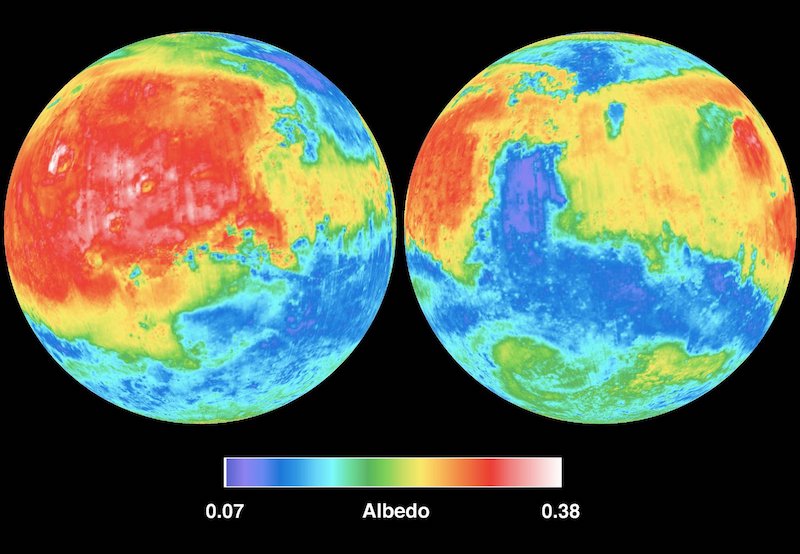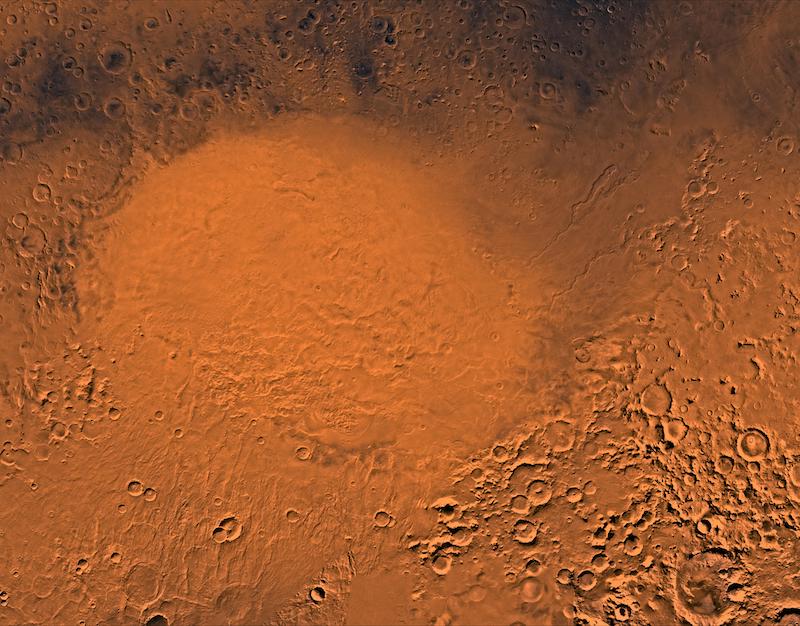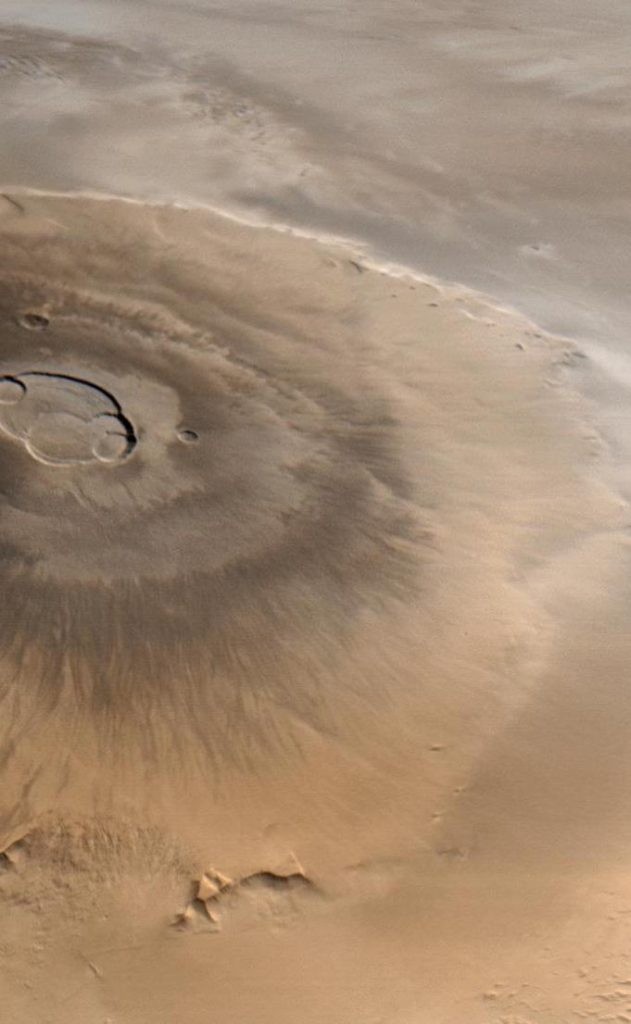Mars is certainly one of the more interesting planets I’ve viewed through a telescope. Being the only planet in the solar system with actual surface features we can see (Mercury is tiny and rarely easily viewed, and Venus has its obscuring clouds), as well as hosting dust storms and two moons, there is certainly a lot to look at. The allure of Mars, its Earth-like status, and the possibility of hosting life have also attracted stargazers for centuries, myself included.
Mars, often referred to as the “Red Planet,” stands out in the Solar System with its distinctive red-orange hue. When sunlight reaches Mars, it illuminates the dust particles suspended in the Martian atmosphere, further amplifying the reddish hue. This reddish dust not only colors the planet itself but also gives the sky on Mars’ surface a tawny, pinkish color, particularly at sunrise and sunset.
First, let’s go over some of the important things you need to view Mars with your telescope.
When to See Mars the Best
Mars only makes a close approach to Earth once every 26 months, and it is at its closest to us approximately around when it appears 180 degrees from the Sun in the sky, known as opposition. For a few months around either side of that date, it is big enough in the sky to easily view surface features. For the rest of the time, Mars appears rather small, and it is far more difficult to discern any surface features. Mars and its moons also appear much brighter at opposition.

The next opposition will occur in February 2027, with subsequent ones in March 2029 and May 2031. Unfortunately, Mars is getting closer to the aphelion, and the next “good” (i.e., close to perihelic) oppositions won’t be until the late 2030s.
Tips for Buying/Using a Telescope for Observing Mars
In my experience, any good telescope can be exciting for viewing Mars, even with just a few inches of aperture. However, I’ve also learned that good optics, good collimation, and good conditions are paramount. A good telescope is of no use if the collimation is bad or it hasn’t cooled down.
If you own a Newtonian or Schmidt-Cassegrain type of telescope, you should check your collimation before every observing session and make sure it is as perfect as you can get it before viewing Mars. If you’re unsure how to collimate or check collimation, read our guide. With refractors and Maksutov-Cassegrains, you shouldn’t have to worry much about collimation.
Cooldown affects all telescopes, though refractors suffer from the least cooldown issues. Even if the air temperature is only a few degrees lower than indoors, your scope’s objective lens or mirror will warp as a result of the temperature change and suffer from blurry images.
The lower Mars or any object is in the sky, the more atmospheric seeing will affect it. For best results, I always try to observe Mars when it is at its highest in the sky.
The larger our telescope, the more angular resolution it has and the smaller the details we can see. Unlike light-gathering ability, which scales with the square of the aperture, the resolution is linear, so an 8” telescope will have twice the resolution of a 4” telescope.
However, once I get past about 10” or 12” or so, it is rare that I’ll ever have a night of seeing good enough to utilize the full resolution enabled by the telescope’s aperture. At that point, I’d say it makes more sense to prioritize optical quality over aperture if you are able to afford a large telescope.
A telescope with poor optical quality or defects can make a huge difference in being able to view significant detail on Mars. Anything short of optimal will result in light scatter, smearing of the image, or a complete inability to focus at high power. Thankfully, unless you have bought a really low-quality telescope, this is usually not a problem.
A fast achromatic refractor will show severe chromatic aberration, blurring fine detail, and so, I wouldn’t recommended it for viewing Mars.
Mars Special Features to Look Out For
- Phases of Mars
Mars, like Venus and Mercury, goes through phases when viewed from Earth. These phases are due to the relative positions of Mars, Earth, and the Sun.
When Mars is on the opposite side of Earth from the Sun (at opposition), it appears fully illuminated; this is its “full” phase.
As Mars moves away from opposition and closer to conjunction (when Mars is on the same side of the Earth as the Sun), it passes through a gibbous phase (more than half illuminated but not fully illuminated) and then a crescent phase (less than half illuminated). However, Mars’ phases are less dramatic than those of Venus and Mercury because Mars orbits outside Earth’s orbit, so we never see it as a thin crescent.
Besides an occasional slight phase, Mars displays three main types of features through an amateur telescope: Albedo markings, polar caps, and dust storms.
- Albedo Markings
Albedo features on Mars are lighter or darker regions that reflect different amounts of sunlight, due to the varying composition and texture of the Martian surface. Large albedo features are visible even through small telescopes, and many have names, often based on the original names given by early observers.
Some of the most prominent include Syrtis Major Planum, a dark feature thought to be a relatively low dust region, and Hellas Planitia, which is a large impact basin that often appears bright due to frost or fog.

These albedo features, however, are not static—they change over time due to wind-blown dust covering and uncovering the underlying surface. These variations have intrigued Mars observers and added a dynamic aspect to the study of the planet.
Many astronomers in the past thought they saw “canals” on Mars. However, these linear features were usually caused by issues with the telescope, namely internal reflections; these observers would use ludicrous magnification with small apertures to the point that they would end up looking at reflections of magnified blood vessels in their eyes or spurious aberrations from the Earth’s atmosphere and confuse it for detail. There are no canals on Mars, and there never were any.
Some of the Martian albedo features do in fact correspond to topographical features, such as the Aurorae Sinus region, which is, in fact, part of the massive canyon Valles Marineris, Nix Olympica, which corresponds to Olympus Mons, the largest volcano in the solar system -, and, of course, Hellas Planitia, a giant ancient crater. However, most of the larger and thus more easily observed albedo regions are just patches of dark terrain.


- Polar Caps
Mars’ polar caps are pretty self-explanatory—frozen deposits of water and carbon dioxide ice at the poles. Because Mars has an axial tilt very much like Earth, we’ll usually only easily see one at any one time, with the other at least partially, if not fully, shrouded in darkness on the non-observable side of Mars.
The polar caps are undoubtedly the easiest Martian feature to observe with a telescope, and almost any telescope will show them with at least 50x magnification or so around the opposition.
- Dust Storms
Lastly, there are dust storms. I’ve seen Martian dust storms that vary widely, from small orange-yellow patches to global storms that all-but-obscure even the most prominent albedo features and the ice caps.
Conjunctions & Occultations of Mars
In astronomy, a conjunction occurs when two astronomical objects have the same right ascension or the same ecliptic longitude, usually as observed from Earth. When it comes to Mars, a conjunction happens when it aligns with another planet or the Sun as seen from Earth.
The most notable of these is perhaps the Mars-Sun superior conjunction, which happens approximately once every 26 months. During this period, Mars is nearly opposite the Sun in our sky, making it difficult to observe because it rises and sets with the Sun. Conjunctions between Mars and other planets are less regular but can provide a beautiful spectacle for stargazers, with two or more planets appearing close together in the sky.
- For instance, on November 12, 2025, Mars will form a fairly close conjunction with Mercury, albeit very low in the pre-dawn sky, offering a rare spectacle for observers. Mercury and Mars will appear about 1.3 degrees apart, almost 2.5x the diameter of the Moon or Sun in the sky—easily visible in the same view at medium power in a telescope or with handheld binoculars.
- A more closer conjunction happens on 08 Jan, 2028 when the angular distance is just 43 arc minutes, just 40% bigger than the angular diameter of the Moon.
- However, the next most exciting conjunction will occur on 24 Nov, 2027. Mars and Venus will appear as close together as 18 arc minutes, which is slightly less than the diameter of the full Moon in the sky. Both planets will be visible in the evening sky shortly after sunset.
Conversely, an opposition (the opposite of a conjunction) is a prime time to observe and study Mars, as the planet is fully illuminated by the Sun and is visible throughout the night.
Occultations occur when one celestial body passes in front of another, hiding the latter from view. Occasionally, the Moon occults Mars as seen from Earth, which happens at least once or twice in most years. However, most viewers will just see a close conjunction between the Moon and Mars—still spectacular.
Moons of Mars with a Telescope
Both Phobos and Deimos are rather dim and really require at least an 8” telescope to see.
Phobos orbits extremely close to Mars—so close, in fact, that it is only really observable when Mars is very close to opposition. Most of the time, it is too close to Mars in the sky and appears too dim to spot. Even with Mars favorably positioned, I’ll need to wait for Phobos to be at an optimal elongation from the planet, which, thankfully, occurs at least twice a night thanks to Phobos’ 7 hour, 40-minute orbital period. Even then, I’ll need to put a strip of tape or a similar occulting bar-like device across the center of my eyepiece’s field lens to block out Mars itself to shield Phobos from its glare at least partially.
Deimos is much easier. An 8” or larger scope with a good eyepiece can reveal the tiny asteroid, and observers with telescopes as small as 6” in aperture have spotted it. As with Phobos, an occulting bar is ideal for attempting to spot Deimos, and I must do it within a month or so around opposition, when the moons appear brightest and most distant from Mars.
Telescope Color Filters for Observing Mars
Some observers recommend using various telescope filters to bring up the contrast, or a neutral-density filter to bring down Mars’ brightness. Most are largely useless, either due to poor optical quality or a negligible contrast boost.
However, I highly recommend the Baader Neodymium Moon and Skyglow filter for observing Mars from a telescope. It tones down some glare and any residual chromatic aberration from your eyepiece and enhances the vivid red and orange tones of the planet.
A #21 orange filter is also used by some observers, though make sure to get a good one from a known brand so it doesn’t mess up the view.
